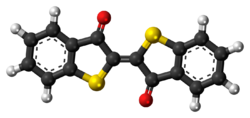Chemistry:Thioindigo
From HandWiki

| |

| |
| Names | |
|---|---|
| Preferred IUPAC name
[2(2′)E]-3H,3′H-[2,2′-Bi-1-benzothiophenylidene]-3,3′-dione | |
| Other names
DyStar, C.I. Vat Red 41, C.I. 73 300
| |
| Identifiers | |
3D model (JSmol)
|
|
| ChemSpider | |
PubChem CID
|
|
| UNII | |
| |
| |
| Properties | |
| C16H8O2S2 | |
| Molar mass | 296.36 g·mol−1 |
| Appearance | Red solid |
| Melting point | 280 °C (536 °F; 553 K) |
| Insoluble | |
| Solubility in ethanol, xylene | Soluble[vague] |
Except where otherwise noted, data are given for materials in their standard state (at 25 °C [77 °F], 100 kPa). | |
| Infobox references | |
Tracking categories (test):
Thioindigo is an organosulfur compound that is used to dye polyester fabric. A synthetic dye, thioindigo is related to the plant-derived dye indigo, replacing two NH groups with two sulfur atoms to create a shade of pink.
Thioindigo is generated by the alkylation of the sulfur in thiosalicylic acid with chloroacetic acid. The resulting thioether cyclizes to 2-hydroxythianaphthene, which is easily converted to thioindigo.[1] The related compound 4,7,4',7'-tetrachlorothioindigo, also a commercially important dye (Pigment Red 88), can be prepared by chlorination of thioindigo.
References
- ↑ Elmar Steingruber "Indigo and Indigo Colorants" in Ullmann's Encyclopedia of Industrial Chemistry, 2004, Wiley-VCH, Weinheim. doi: 10.1002/14356007.a14_149.pub2
 |

